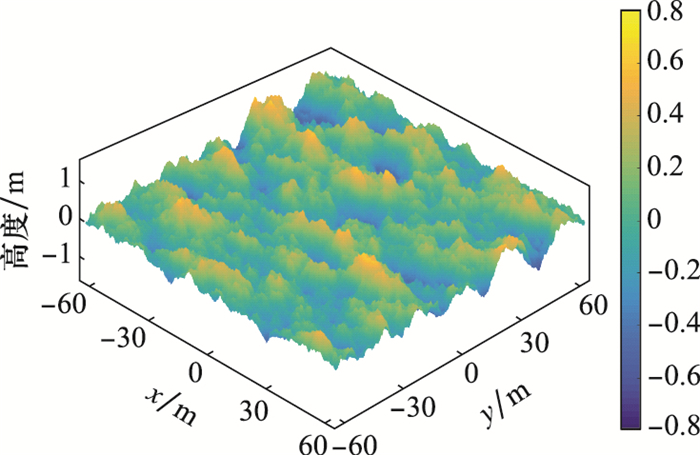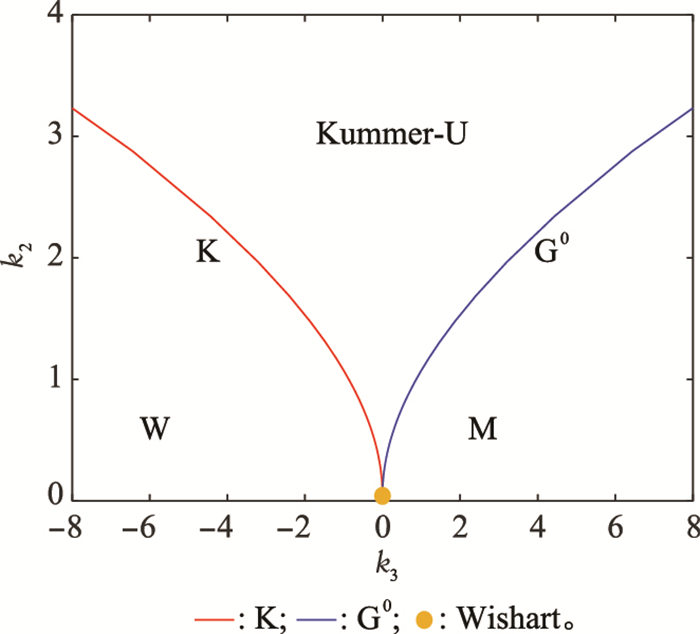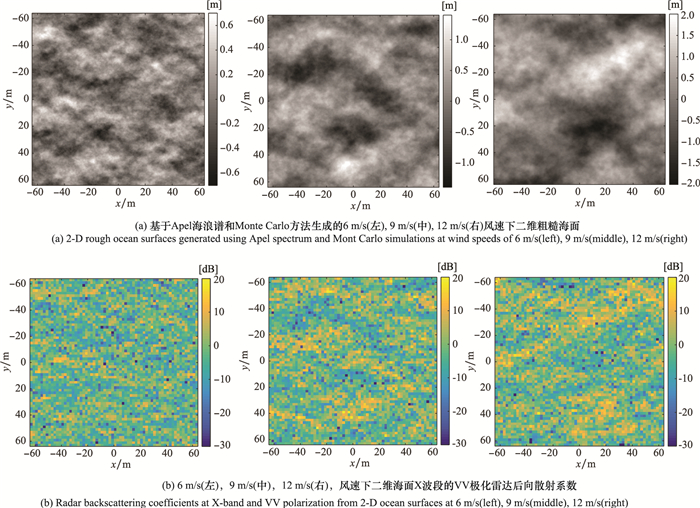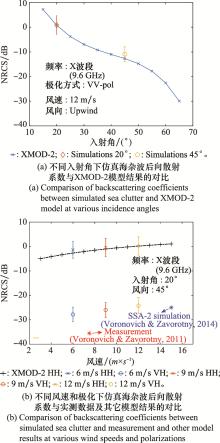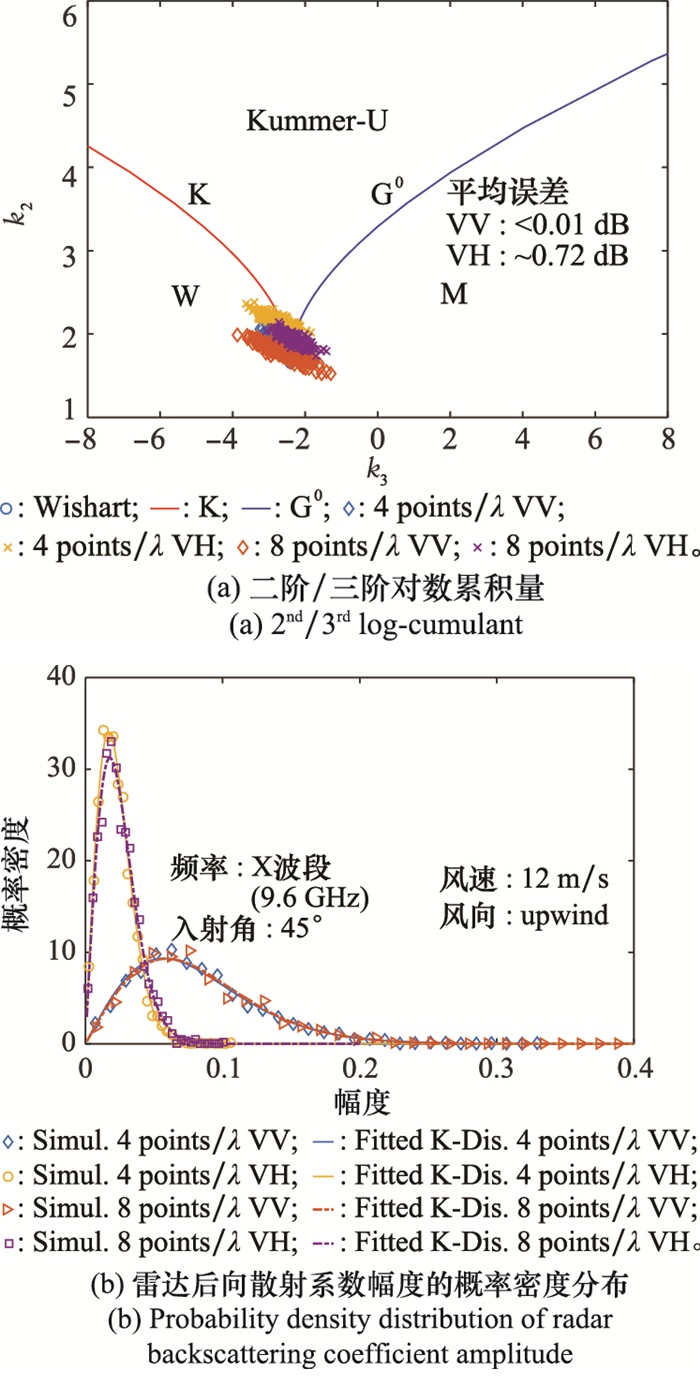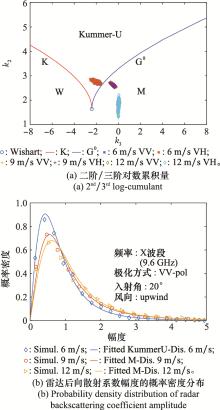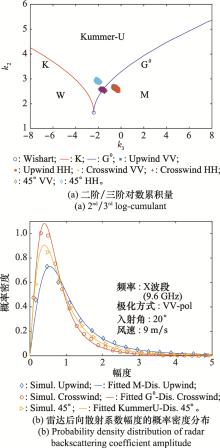Systems Engineering and Electronics ›› 2021, Vol. 43 ›› Issue (10): 2742-2755.doi: 10.12305/j.issn.1001-506X.2021.10.06
• New progress in electromagnetic scattering and inverse scattering • Previous Articles Next Articles
Statistical modeling and characteristic analysis of polarimetric SAR sea clutter at X-band based on numerical simulations
Yanlei DU1,2, Fan GAO2, Tao LIU3, Jian YANG2,*
- 1. Aerospace Information Research Institute, Chinese Academy of Sciences, Beijing 100101, China
2. Department of Electronic Engineering, Tsinghua University, Beijing 100084, China
3. School of Electronic Engineering, Naval University of Engineering, Wuhan 430033, China
-
Received:2021-08-03Online:2021-10-01Published:2021-11-04 -
Contact:Jian YANG
CLC Number:
Cite this article
Yanlei DU, Fan GAO, Tao LIU, Jian YANG. Statistical modeling and characteristic analysis of polarimetric SAR sea clutter at X-band based on numerical simulations[J]. Systems Engineering and Electronics, 2021, 43(10): 2742-2755.
share this article
"
| 分布模型 | 纹理参数τ | 散射向量k的PDF | 极化协方差矩阵C的PDF | 公式编号 | |
| 模型 | |||||
| K分布 | γ分布 | (32) | |||
| G0分布 | 逆γ分布 | (33) | |||
| Kummer-U分布 | Fisher分布 | (34) | |||
| W分布 | β分布 | (35) | |||
| M分布 | 逆β分布 | (36) | |||
Table 2
Log-cumulants of typical texture distribution models"
| 纹理模型 | 对数累积量υv{τ} |
| γ分布 | |
| 逆γ分布 | |
| Fisher分布 | |
| β分布 | |
| 逆β分布 |
| 1 | 丁昊, 刘宁波, 董云龙, 等. 雷达海杂波测量试验回顾与展望[J]. 雷达学报, 2019, 8 (3): 281- 302. |
| DING H , LIU N B , DONG Y L , et al. Overview and prospects of radar sea clutter measurement experiments[J]. Journal of Radars, 2019, 8 (3): 281- 302. | |
| 2 | 许述文, 白晓惠, 郭子薰, 等. 海杂波背景下雷达目标特征检测方法的现状与展望[J]. 雷达学报, 2020, 9 (4): 684- 714. |
| XU S W , BAI X H , GUO Z X , et al. Status and prospects of feature-based detection methods for floating targets on the sea surface[J]. Journal of Radars, 2020, 9 (4): 684- 714. | |
| 3 | 刘宁波, 董云龙, 王国庆, 等. X波段雷达对海探测试验与数据获取[J]. 雷达学报, 2019, 8 (5): 656- 667. |
| LIU N B , DONG Y L , WANG G Q , et al. Sea-detecting X-band radar and data acquisition program[J]. Journal of Radars, 2019, 8 (5): 656- 667. | |
| 4 | 丁昊, 董云龙, 刘宁波, 等. 海杂波特性认知研究进展与展望[J]. 雷达学报, 2016, 5 (5): 499- 516. |
| DING H , DONG Y L , LIU N B , et al. Overview and prospects of research on sea clutter property cognition[J]. Journal of Radars, 2016, 5 (5): 499- 516. | |
| 5 | TSANG L , KONG J A , SHIN R T . Scattering of electromagnetic waves: numerical simulations[M]. New York: Wiley, 2000, 2nd ed |
| 6 | ULABY F T , LONG D G . Microwave radar and radiometric remote sensing[M]. Ann Arbor: University of Michigan Press, 2015. |
| 7 | FUNG A K . Microwave scattering and emission models and their applications[M]. Boston: Artech House, 1994. |
| 8 | 杨健, 殷君君. 极化雷达理论与遥感应用[M]. 北京: 科学出版社, 2020. |
| YANG J , YIN J J . Polarimetric radar theory and remote sensing application[M]. Beijing: Science Press, 2020. | |
| 9 |
LIU T , ZHANG J F , GAO G , et al. CFAR ship detection in polarimetric synthetic aperture radar images based on whitening filter[J]. IEEE Trans.on Geoscience and Remote Sensing, 2020, 58 (1): 58- 81.
doi: 10.1109/TGRS.2019.2931353 |
| 10 | DENG X P , LOPEZ-MARTINEZ C , CHEN J S , et al. Statistical modeling of polarimetric sar data: a survey and challenges[J]. Remote Sensing, 2017, 9 (4): 25817172. |
| 11 | 郭立新, 王蕊, 吴振森. 随机粗糙面散射的基本理论与方法[M]. 北京: 科学出版社, 2010. |
| GUO L X , WANG R , WU Z S . Basic theory and method of random rough surface scattering[M]. Beijing: Science Press, 2010. | |
| 12 |
石志广, 周剑雄, 付强. K分布海杂波参数估计方法研究[J]. 信号处理, 2007, (3): 420- 424.
doi: 10.3969/j.issn.1003-0530.2007.03.023 |
|
SHI Z G , ZHOU J X , FU Q . Parameter estimation study of K distributed sea clutter[J]. Signal Processing, 2007, (3): 420- 424.
doi: 10.3969/j.issn.1003-0530.2007.03.023 |
|
| 13 |
吴振森, 衣方磊. 一维动态海面的电磁散射杂波模拟和参数估计[J]. 电波科学学报, 2003, (2): 132- 137.
doi: 10.3969/j.issn.1005-0388.2003.02.003 |
|
WU Z S , YI F L . Numerical simulation and parameters estimation of scattering clutter from 1-D time-varying sea surface[J]. Chinese Journal of Radio Science, 2003, (2): 132- 137.
doi: 10.3969/j.issn.1005-0388.2003.02.003 |
|
| 14 | NICOLAS J M . Introduction to second kind statistics: application of Log-moments and Log-cumulants to SAR image law analysis[J]. Traitement du Signal, 2002, 19 (3): 139- 167. |
| 15 |
ANFINSEN S N , ELTOFT T . Application of the matrix-variate mellin transform to analysis of polarimetric radar images[J]. IEEE Trans.on Geoscience and Remote Sensing, 2011, 49 (6): 2281- 2295.
doi: 10.1109/TGRS.2010.2103945 |
| 16 | 杜延磊. 随机粗糙海面微波散射/辐射的仿真与分析: 解析近似模型和数值方法[D]. 北京: 中国科学院遥感与数字地球研究所, 2019. |
| DU Y L. Simulations and analyses of microwave scattering and emission from randomly rough ocean surfaces: analytic approximate models and numerical methods[D]. Beijing: Institute of Remote Sensing and Digital Earth, Chinese Academy of Sciences, 2019. | |
| 17 |
DU Y L , YIN J J , TAN S R . A numerical study of roughness scale effects on ocean radar scattering using the second-order SSA and the moment method[J]. IEEE Trans.on Geoscience and Remote Sensing, 2020, 58 (10): 6874- 6887.
doi: 10.1109/TGRS.2020.2977368 |
| 18 | QIAO T , DU Y L , TSANG L , et al. Radar scattering of ocean surface with anisotropic ocean spectrum using NMM3D simulations[M]. Boca Raton: CRC Press, 2018. |
| 19 | APEL J R . An improved model of the ocean surface-wave vector spectrum and its effects on radar backscatter[J]. Geophys Res-Oceans, 1994, 9 (8): 16269- 16291. |
| 20 | DU Y L , YANG X F , CHEN K S , et al. An improved spectrum model for sea surface radar backscattering at L-band[J]. Remote Sensing, 2017, 9 (8): 25251- 25267. |
| 21 |
QIAO T , DU Y L , TSANG L . Electromagnetic scattering and emission by ocean surfaces based on neighborhood impedance boundary condition (NIBC) with dense grid: accurate emissivity and sensitivity to salinity[J]. Progress in Electromagnetics Research B, 2018, 81, 141- 162.
doi: 10.2528/PIERB18050706 |
| 22 |
HASTINGS F D , SCHNEIDER J B , BROSCHAT S , et al. An FDTD method for analysis of scattering from rough fluid-fluid interfaces[J]. IEEE Journal of Oceanic Eng, 2001, 26 (1): 94- 101.
doi: 10.1109/48.917937 |
| 23 |
LOU S H , TSANG L , CHAN C H , et al. Application of the finite-element method to Monte-Carlo simulations of scattering of waves by random rough surfaces with the periodic boundary-condition[J]. Electromagnet Wave, 1991, 5 (8): 835- 855.
doi: 10.1163/156939391X00275 |
| 24 |
DU Y L . Electromagnetic scattering and emission from large rough surfaces with multiple elevations using the MLSD-SMCG method[J]. IEEE Trans.on Geoscience and Remote Sensing, 2021, 59 (7): 5393- 5406.
doi: 10.1109/TGRS.2020.3016997 |
| 25 | YANG J S, DU Y, SHI J C. Polarimetric simulations of bistatic scattering from perfectly conducting ocean surfaces with 3 m/s wind speed at L-band[J]. IEEE Journal of STARS, 9(3): 1176-1186. |
| 26 |
GORDON W B . Far-field approximations to the Kirchoff-Helmholtz representations of scattered fields[J]. IEEE Trans.on Antennas and Propagation, 1975, 23 (4): 590- 592.
doi: 10.1109/TAP.1975.1141105 |
| 27 |
LING H , CHOU R C , LEE S W . Shooting and bouncing rays-calculating the RCS of an arbitrarily shaped cavity[J]. IEEE Trans.on Antenn Propag, 1989, 37 (2): 194- 205.
doi: 10.1109/8.18706 |
| 28 |
ANFINSEN S N , DOULGERIS A P , ELTOFT T . Goodness-of-fit tests for multilook polarimetric radar data based on the mellin transform[J]. IEEE Trans.on Geoscience and Remote Sensing, 2011, 49 (7): 2764- 2781.
doi: 10.1109/TGRS.2010.2104158 |
| 29 | JOHNSON W P . The curious history of Faa di Bruno's formula[J]. Am Math Mon, 2002, 109 (3): 217- 234. |
| 30 |
NIRCHIO F , VENAFRA S . XMOD2—An improved geophysical model function to retrieve sea surface wind fields from Cosmo-Sky Med X-band data[J]. European Journal of Remote Sensing, 2013, 46 (1): 583- 595.
doi: 10.5721/EuJRS20134634 |
| 31 |
VORONOVICH A G , ZAVOROTNY V U . Full-polarization modeling of monostatic and bistatic radar scattering from a rough sea surface[J]. IEEE Trans.on Antenn Propag, 2014, 62 (3): 1362- 1371.
doi: 10.1109/TAP.2013.2295235 |
| 32 | VORONOVICH A G, ZAVOROTNY V U. Depolarization of microwave backscattering from a rough sea surface: modeling with small-slope approximation[C]//Proc. of the IEEE International Geoscience and Remote Sensing Symposium, 2011: 2033-2036. |
| 33 | 刘宁波, 丁昊, 黄勇, 等. X波段雷达对海探测试验与数据获取年度进展[J]. 雷达学报, 2021, 10 (1): 173- 182. |
| LIU N B , DING H , HUANG Y , et al. Annual progress of the sea-detecting X-band radar and data acquisition program[J]. Journal of Radars, 2021, 10 (1): 173- 182. |
| [1] | Yanling SHI, Lei WANG, Junhao LI. CFAR detection for small targets on sea surface based on singular value decomposition in projection space [J]. Systems Engineering and Electronics, 2022, 44(2): 512-519. |
| [2] | Chunling XUE, Fei CAO, Qing SUN, Jianqiang QIN, Xiaowei FENG. Sea-surface weak target detection based on multi-feature information fusion [J]. Systems Engineering and Electronics, 2022, 44(11): 3338-3345. |
| [3] | Weiqiang YU, Fei WANG, Ping SUN, Jianjiang ZHOU, Jun CHEN. RF stealth optimization of airborne radar signal parametersunder clutter background [J]. Systems Engineering and Electronics, 2021, 43(11): 3194-3201. |
| [4] | Sainan SHI, Zeyuan DONG, Jing YANG, Chunjiao YANG. Sea-surface small target detection based on autonomic learning of time-frequency graph [J]. Systems Engineering and Electronics, 2021, 43(1): 33-41. |
| [5] | Xin LI, Xiaoyun XIA, Yushi ZHANG, Penglang SHUI, Jinpeng ZHANG. Modified reflectivity model of UHF-band sea clutter at low grazing angle [J]. Systems Engineering and Electronics, 2020, 42(5): 1035-1040. |
| [6] | Hai LI, Zhixin LIU, Weijie CHENG, Zibo ZHUANG, Yi FAN. Low-altitude wind shear wind speed estimation method based on MBMC under sea clutter [J]. Systems Engineering and Electronics, 2020, 42(11): 2481-2487. |
| [7] | Ziwei DONG, Jun SUN, Jingming SUN, Meiyan PAN. Marine weak moving target detection based on sparse dictionary learning [J]. Systems Engineering and Electronics, 2020, 42(1): 30-36. |
| [8] | HUANG Chenxia, YIN Junjun, YANG Jian. Polarimetric SAR change detection with l1-norm principal component analysis [J]. Systems Engineering and Electronics, 2019, 41(10): 2214-2220. |
| [9] | SHI Yanling, LIN Yufeng, LIANG Dandan. Subband segmented ANMF detector in non-stationary sea clutter [J]. Systems Engineering and Electronics, 2018, 40(4): 782-789. |
| [10] | ZHAO Wenjing, JIN Minglu, LIU Wenlong. Modified median matrix detection method for sea clutter environment [J]. Systems Engineering and Electronics, 2018, 40(10): 2173-2179. |
| [11] | XU Xinyu, ZHANG Yushi, LI Xin, LI Shanbin, LI Huiming. Influence of sea condition on the temporal correlation properties of UHF band sea clutter [J]. Systems Engineering and Electronics, 2017, 39(6): 1203-1207. |
| [12] | ZHANG Haiying, LI Zhenfang, XIE Jinwei. Channel error calibration for automobile-based fully polarimetric InSAR system [J]. Systems Engineering and Electronics, 2017, 39(2): 298-303. |
| [13] | SHI Sainan, SHUI Penglang, YANG Chunjiao, XU Shuwen. Radar target detection based on spatial correlation of inverse-Gaussian texture [J]. Systems Engineering and Electronics, 2017, 39(10): 2215-2220. |
| [14] | GUO Yue-yu, WEI Yin-sheng, XU Rong-qing, LU Yao-bing. Geometry design of two-dimensional non-filled array for multimode separation in skywave radar [J]. Systems Engineering and Electronics, 2016, 38(9): 2033-2039. |
| [15] | HAN Ping, CHANG Ling, CHENG Zheng, SHI Qing-yan. Runways detection based on h/q decomposition and iterative Bayesian classification [J]. Systems Engineering and Electronics, 2016, 38(9): 2048-2054. |
| Viewed | ||||||
|
Full text |
|
|||||
|
Abstract |
|
|||||

